Round One is underway! This year’s Middle-earth March Madness tournament focuses not on characters, costumes, or movie moments, as with previous years. Instead, milestone events are stepping into the competitive arena: major creations, critical turning points, the founding and breaking of kingdoms, births, deaths, victories and defeats. These events appear in four competing divisions, each representing one of the epic ages that comprise the history of Arda and Middle-earth: Ages One through Three, along with the foundations – the ‘Pre-First Age’ that unfolded before the rising of the Sun and Moon.
Even casual fans are likely to be familiar with many of the landmark events of the Third Age,
especially those covered by The Hobbit and The Lord of the Rings. With Amazon’s entry into the Tolkienverse, we will soon be drawn into a more extensive familiarity with Second Age affairs, like the rise and fall of Númenor and the forging of the Rings of Power. Thanks to the enduring body of work curated by Tolkien’s son, Christopher, we have a rich pool of resources covering First Age affairs, like the romance of Beren and Lúthien, the tragedies of the Children of Húrin, and the fall of the elven kingdom of Gondolin.
But what happened beforehand, “in the beginning”, between Eru Ilúvatar and the Valar singing Arda and Eä into existence, and the awakening of “Mortal Men, doomed to die,” as the new Sun and Moon rose over Middle-earth? As you fill out that first ‘Regional’ in our Battle of the Ages, perhaps a bit of background on our 16 Pre-First Age contenders may help!
Matchup One: The Creation of Eä and Arda versus The Creation of the Two Lamps
Creation of Eä and Arda (Valian Year (VY) 0): the first chapter of the Silmarillion, the Ainulindalë, describes how Tolkien’s supreme Creator, Eru Ilúvatar, and the Valar brought into existence the heavens (Eä) and the Earth (Arda). This “Music of the Ainur” laid the foundation for all of time and history according to Ilúvatar’s purposes, despite and even through the dissonance introduced by Sauron’s powerfully evil predecessor, Melkor/Morgoth.
The Two Lamps (VY 1900): in the first “let there be light” moment on Arda, the Vala Aulë created two great lamps, one in the North of the world (Illuin) and one in the South (Ormal). They were set on two great pillars, and their every-present light mingled in the center of Arda and the dwelling place of the Valar on the island of Almaren. These pillars and their supported lamps were later destroyed by Melkor (in VY 3450), with great collateral damage to the surrounding lands, resulting in the migration of the Valar to the utter West in Aman, and the establishment of Valinor.

Matchup Two: The Creation of the Two Trees versus The Creation of the Dwarves
The Two Trees (VY 3500/Years of the Trees (YT) 1): With their move to Aman after the destruction of the Two Lamps, the Valar required a new form of light, and commissioned Yavanna, the Giver of Fruits and the Vala of growing things, to create two trees: Telperion, the Silver Tree, and Laurelin, the Gold. Both sources of light, each tree waxed and waned in alternate cycles over the course of a Valarian day, with one overlapping hour of “dawn” and “dusk” each day. Through many fortunate generations, Telperion was the forebear to the White Tree of Gondor.
The Creation of the Dwarves (YT 1001): Arda and Middle-earth were created to be full of life, and especially populated by the Children of Ilúvatar: the races of Elves and Men. The Vala Aulë, however, grew impatient for them to appear, choosing to create his own “children” to whom he could teach his passion for making and craft: the race of Dwarves. After making the Seven Fathers of Dwarves, Aulë recognized that giving life to his new creation was beyond his power and mandate. He was reprimanded by Ilúvatar, who also stopped Aulë from destroying these first dwarven fathers. Instead, they were put to sleep, only to reemerge roughly a century after Ilúvatar’s firstborn, the Elves, were awakened.
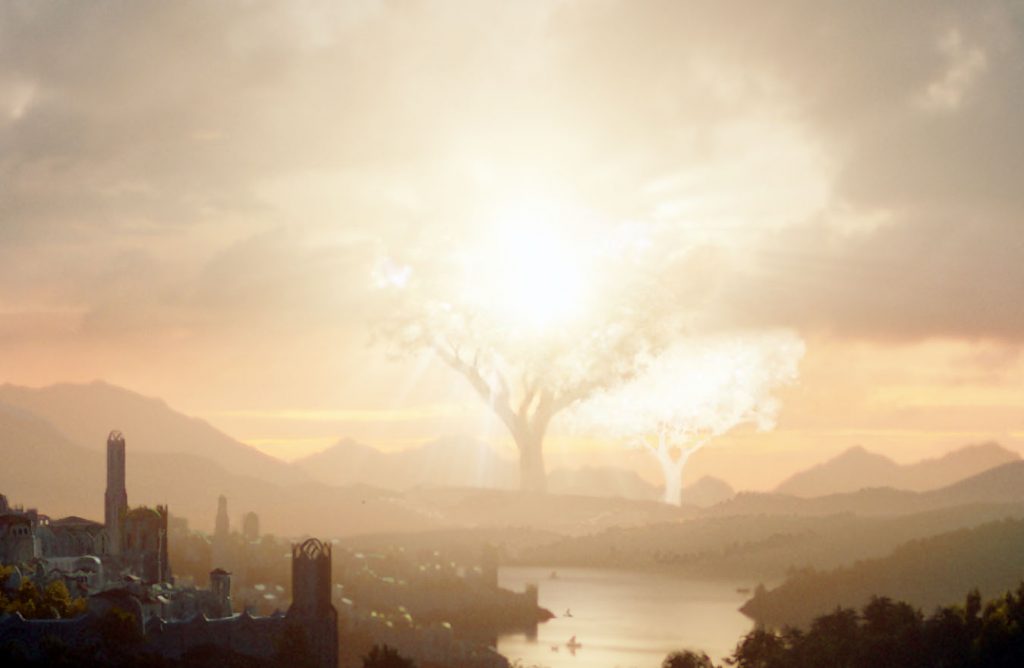
Matchup Three: The Creation of the Ents versus The Awakening of the Elves
The Creation of the Ents (c. YT 1001): After learning of her husband Aulë’s creation of the Dwarves, and recognizing that their hunger toward great building and mining would require fuel to flourish, the Vala Yavanna feared for the felling of her great love, the Trees. In response, she is thought to have created the Onodrim, or Ents, shortly after the creation of the Dwarves, intending them to serve as shepherds and defenders of the great forests of Middle-earth. While the Onodrim were sentient, it was the Elves who later brought the gift of speech to the Ents.
The Elves Awake (YT 1050): the first 144 Elves were awakened under the stars by Eru Ilúvatar near Cuiviénen, a bay in the great inland sea of Helcar, far to the east in Middle-earth. The full number awoke gradually, beginning with Imin (“First”) and his wife Iminyë. They were followed by the couples Tata (“Second”) and Tatië, and then Enel (“Third”) and Enelyë. These families became the gatherers and founders of the three great Elven houses, eventually known as the Vanyar, the Noldor, and the Teleri.
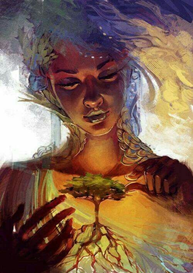
Matchup Four: Melkor is Chained versus The Eldar Come to Valinor
Melkor Defeated and Chained (YT 1099): After destroying the Two Lamps, Melkor intensified his efforts to dominate Middle-earth according to his own designs, even as the rest of the Valar withdrew to Valinor in the West. Melkor strengthened his supporting hosts of evil creatures, built a second great fortress in west of Middle-earth, Angband, to complement his northern stronghold of Utumno, and, once the Elves were awakened, sought to corrupt Ilúvatar’s firstborn. This threat to the Elves ultimately provoked the Valar to take action in the War of the Powers (YT 1090-1099), the siege and downfall of Utumno, and the capture of Melkor. He was ultimately defeated by the Vala Tulkas, and brought before the Vala Manwë for judgement bound in the great chain Angainor, forged by Aulë. Melkor was imprisoned in the Halls of Mandos, though his chief lieutenant, Sauron, remained at large in Middle-earth.
The Journey of the Eldar to Valinor (YT 1102): The imprisonment of Melkor provided a season of peace and growth for newly awakened Elves, or Eldar. Even so, existential threats and corrupting powers remained active in Middle-earth. The Valar concluded that they could best protect Ilúvatar’s children by encouraging them to emigrate to Valinor rather than remain in Middle-earth. Three ambassadors from the Great Houses of the Elves, Ingwë, Finwë, and Elwë, were selected by the Vala Oromë, and invited to journey to Valinor, where they first beheld the light of the Two Trees. The three Elven-kings ultimately persuaded many of their kindred to journey to Aman, particularly the houses of the Vanyar and the Noldor.
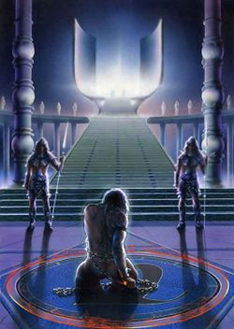
Matchup Five: Khazad-dûm Founded versus The Birth of Lúthien
The Founding of Khazad-dûm (YT 1050-1250): Shortly after the Elves awoke, the race of Dwarves was roused from their sleep under Mount Gundabad in the northern mountains of Middle-earth, beginning with Durin the Deathless. Deciding to move southward, Durin ultimately found “a glen of shadows between two great arms of the mountains, above which three white peaks were shining.” Confirmed by a vision of a crown of stars in the lake Kheled-zâram, or the Mirrormere, Durin chose to establish the first Dwarven Kingdom in this valley of Azanulzibar, or the Dimrill Dale. This Golden Age of “Durin’s Day” saw the construction of wonders like Durin’s Tower, the Endless Stair, Durin’s Bridge, and the Second Hall of the Dwarrowdelf, or Moria.
The Birth of Lúthien (YT 1200): Renowned as one of the most beautiful of all the Children of Ilúvatar, Lúthien Tinúviel was the daughter of one of the original Elven kings, Elu Thingol, and his Queen, Melian, one of the Maiar who assisted in the creation of Arda and Middle-earth. She was raised within the peace and protection of the forest of Doriath, where her enchanting powers of song and dance, along with her night-dark hair, grew to be formidable. Her union with the mortal man, Beren, and quest for a Silmaril, will be prominent events in the First Age. (Tolkien assigned the name of Lúthien to his wife, Edith, on their tombstone in Oxford.)
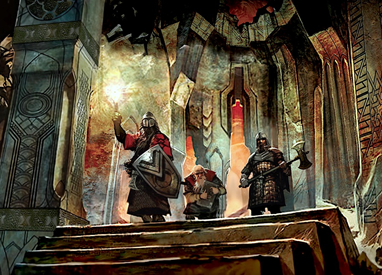
Matchup Six: Fëanor Creates the Silmarils versus The Destruction of the Two Trees
Fëanor Creates the Three Silmarils (YT 1450): Fëanor, a Noldorian Elf and possibly the greatest craftsman in the history of the Eldar, created three brilliant jewels to capture the pure light of Valinor’s Two Trees, Laurelin and Telperion. The Silmarillion describes these jewels as “the most renowned of all the works of the Elves.” The Silmarils were hallowed by the Vala and Star-kindler, Varda, such that they would burn any evil creature or mortal that would dare touch them undeservedly. They were nevertheless immediately coveted by Morgoth, now released from his bondage under the pretense of repentance. The Jewels became the catalyst for much of the history of the First Age of Middle-earth: heroics, wars, betrayals, deaths, dowries, crushed kingdoms, and risen hopes. Only one Silmaril has survived to the present Age, and is visible traversing the morning or evening skies – the brightest object in the heavens after the Sun and Moon.
Melkor and Ungoliant Destroy the Two Trees (YT 1495): Having secured his release from the Halls of Mandos through a façade of repentance, Melkor continued to secretly plot the ruin of Valinor and the destruction of the Elves. The chief elements of Melkor’s plans involved the theft of the three Silmarils, and his escape from Aman back to Middle-earth. Melkor directed his initial assault once again toward Valinor’s sustaining Lights, the Two Trees. He was aided by Ungoliant, a primordial Evil in the shape of a great spider, from whom Shelob was descended. Concealed by Ungoliant’s “Unlight”, Melkor pierced the Trees with a spear, and the Great Spider insatiably consumed all light and life in each one. In the aftermath, the Valar Yavanna and Nienna sought to revive the trees through their songs and tears, but in vain. Their efforts did, however, yield Telperion’s last flower (later to become the Moon) and Laurelin’s last fruit (later to become the Sun).
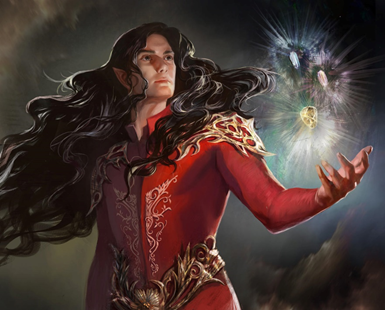
Matchup Seven: The First Elven Kinslaying versus The Doom of Mandos
The First Elven Kinslaying at Alqualondë (YT 1495): Enraged by the murder of his father Finwë, and even more by the theft of his precious Silmarils, Fëanor gives a new name to Melkor: Morgoth. He and his sons made a great, irrevocable Oath to recapture these Jewels regardless of the cost, and to make war on any who would withhold them from their hands. With Morgoth’s flight back to Middle-earth, Fëanor sought to pursue him as quickly as possible, and with as many of the House of the Noldorian Elves as he could muster. Speed required the use of ships to cross the Great Sea, but the Noldor possessed none. Fëanor attempted to persuade another Elven house, the Teleri, to give him the ships in their harbor at Alqualondë, but they refused to help in any way, or to go against the counsel of the Valar. When Fëanor and his sons began to take the ships without consent, a skirmish ensued, with Noldor swords drawn against Teleri bows. The battle swung in Fëanor’s favor with the arrival of a second host of the Noldor and the kindred of his brother, Fingolfin. These late arrivals misunderstood the scene, assumed that the Teleri had initiated the attack, and joined this first tragic slaying of Elf by Elf, the first toxic fruits of Fëanor’s Oath.
The Doom of Mandos (YT 1496): Fëanor’s brash and irrevocable Oath, in rebellion against the Valar, along with the murder of his kinsmen at Alqualondë, had immediately disastrous consequences, best embodied in the Doom of Mandos against the Noldorian Elves: “Tears unnumbered ye shall shed; and the Valar will fence Valinor against you, and shut you out, so that not even the echo of your lamentation shall pass over the mountains… To evil end shall all things turn that they begin well; and by treason of kin unto kin, and the fear of treason, shall this come to pass. The Dispossessed shall they be for ever… Slain ye may be, and slain ye shall be: by weapon and by torment and by grief; and your houseless spirits shall come then to Mandos. There long shall ye abide and yearn for your bodies, and find little pity though all whom ye have slain should entreat for you. And those that endure in Middle-earth… shall grow weary of the world as with a great burden, and shall wane, and become as shadows of regret before the younger race that cometh after. The Valar have spoken.”
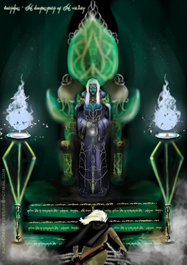
Matchup Eight: The Crossing of the Helcaraxë versus The Creation of the Sun and Moon
The Crossing of the Helcaraxë by the Remaining Noldor Elves (YT 1497): Despite being abandoned by the House of Fëanor, who had made their way back to Middle-earth in stolen Teleri ships, many of the remaining two Houses of the Noldor, descendants of Fingolfin and Finarfin, were still committed to rejoining their kindred; if not to reclaim the Silmarils, then to establish new Kingdoms for themselves. Without ships, the only remaining path across the Great Sea lay to the far north, and the Grinding Ice of the Helcaraxë. Crossing this icy wasteland involved great hardships, and many of the elven host perished in the attempt. Survivors included Fingolfin, Fingon, Turgon, and their cousin/niece, Galadriel. The crossing took years, and was finally completed as the first Moon rose over Middle-earth.
The First Rising of the Sun and Moon Over Middle-earth (YT 1500): Despite the destruction of the Two Trees, there yet remained a single flower from silver Telperion, and a single fruit from golden Laurelin. Aulë and his circle of Maiar made vessels for this silvern flower and fiery fruit, and chose Maiar to steer them and bring new light to Arda: Arien for the vessel of the Sun, and Tilion for the vessel of the Moon. The Moon arose first with the arrival of the Noldorian elves after they had crossed the Helcaraxë, and the Sun appeared seven lunar “days” later. This first solar day also brought with it the awakening of Ilúvatar’s Second Children, the race of Men, and the beginning of the First Age of Middle-earth.
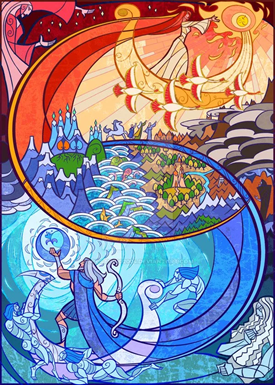
So which event should win, in each of these match ups? Voting is open NOW in Middle-earth March Madness Round One! Find the link to vote in the Pre-First Age bracket here – and stay tuned for a closer look at the match ups in the First and Second Ages! Don’t forget to join us for TORn Tuesday this evening!


